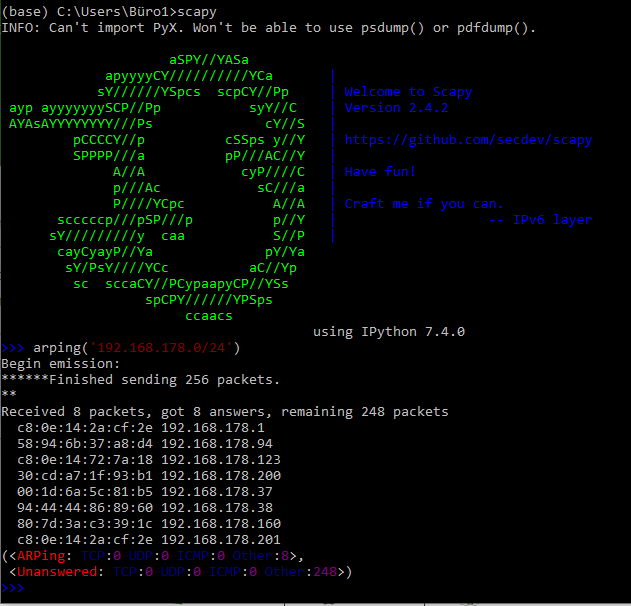
Anyway, Scapy is huge, this post won't be, but I'll hopefully add more as I learn. This blog is proudly powered by Pelican, which takes great advantage of Python. See full list on support.logmeininc.com. Fresh is a responsive theme designed by jsliang and contributors. Welcome to Scapy's documentation!¶ Version. This document is under a Creative Commons Attribution - Non. Scapy is a library made in Python, with its own command line interpreter (CLI), which allows to create, modify, send and capture network packets. It can be used interactively through the command line interface or as a library by importing it into Python programs.
Series: Building Network Tools with Scapy
May - 2019Scapy p.01
Scapy Introduction and OverviewScapy p.02
Installing Python and ScapyScapy p.03
Scapy Interactive ModeScapy p.04
Looking at PacketsScapy p.05
Sending our First Packet; ARP ResponseScapy p.06
Sending and Receiving with ScapyScapy p.07
Monitoring ARPScapy p.08
Making a Christmas Tree PacketScapy p.09
Scapy and DNSScapy p.10
Emulating nmap FunctionsScapy p.11
Scapy Resources
Series: Scapy Sniffing with Custom Actions
May - 2019Scapy Sniffing with Custom Actions
Part 2Scapy Sniffing with Custom Actions
Part 1
Writing Packets to Trace File with Scapy
Simple bunny drawing for children. This is a follow-up post to accompany the previous importing packets from trace files with scapy post. So you've sniffed or generated some packets with scapy and it's time to write them to file to analyze and double-check your work. Here's a simple example of how to save those packets.

Scapy 3

Anyway, Scapy is huge, this post won't be, but I'll hopefully add more as I learn. This blog is proudly powered by Pelican, which takes great advantage of Python. See full list on support.logmeininc.com. Fresh is a responsive theme designed by jsliang and contributors. Welcome to Scapy's documentation!¶ Version. This document is under a Creative Commons Attribution - Non. Scapy is a library made in Python, with its own command line interpreter (CLI), which allows to create, modify, send and capture network packets. It can be used interactively through the command line interface or as a library by importing it into Python programs.
Series: Building Network Tools with Scapy
May - 2019Scapy p.01
Scapy Introduction and OverviewScapy p.02
Installing Python and ScapyScapy p.03
Scapy Interactive ModeScapy p.04
Looking at PacketsScapy p.05
Sending our First Packet; ARP ResponseScapy p.06
Sending and Receiving with ScapyScapy p.07
Monitoring ARPScapy p.08
Making a Christmas Tree PacketScapy p.09
Scapy and DNSScapy p.10
Emulating nmap FunctionsScapy p.11
Scapy Resources
Series: Scapy Sniffing with Custom Actions
May - 2019Scapy Sniffing with Custom Actions
Part 2Scapy Sniffing with Custom Actions
Part 1
Writing Packets to Trace File with Scapy
Simple bunny drawing for children. This is a follow-up post to accompany the previous importing packets from trace files with scapy post. So you've sniffed or generated some packets with scapy and it's time to write them to file to analyze and double-check your work. Here's a simple example of how to save those packets.
Scapy 3
Importing packets from trace files with Scapy
Scapy Tutorial
Scapy is amazingly flexible when it comes to creating packets, but in some cases you may want to mangle or change packets that you've sniffed and saved in a trace file. Scapy currently supports .cap, .pcap, and .pcapng files. Reading these files are possible through the rdpcap() function:

